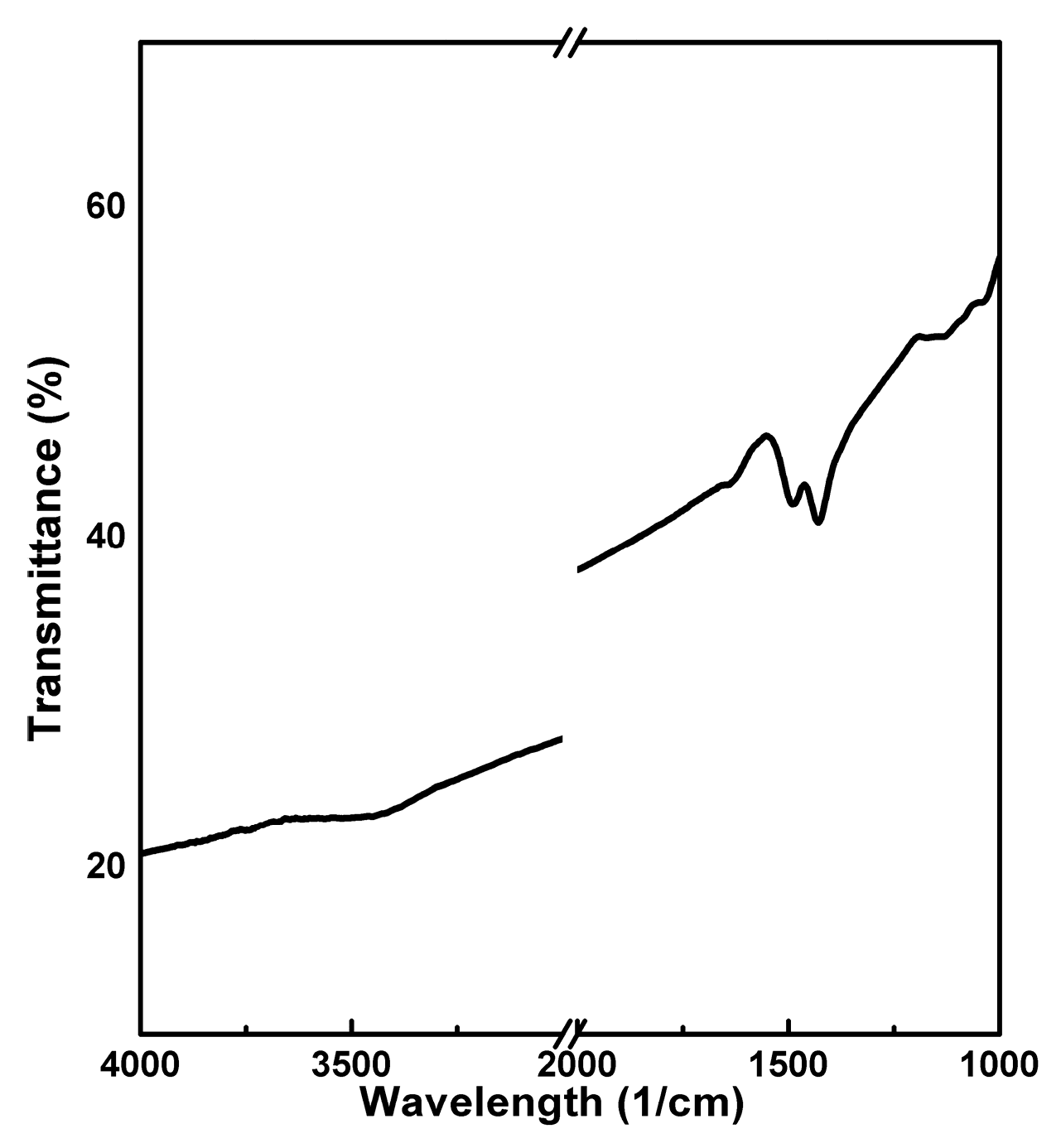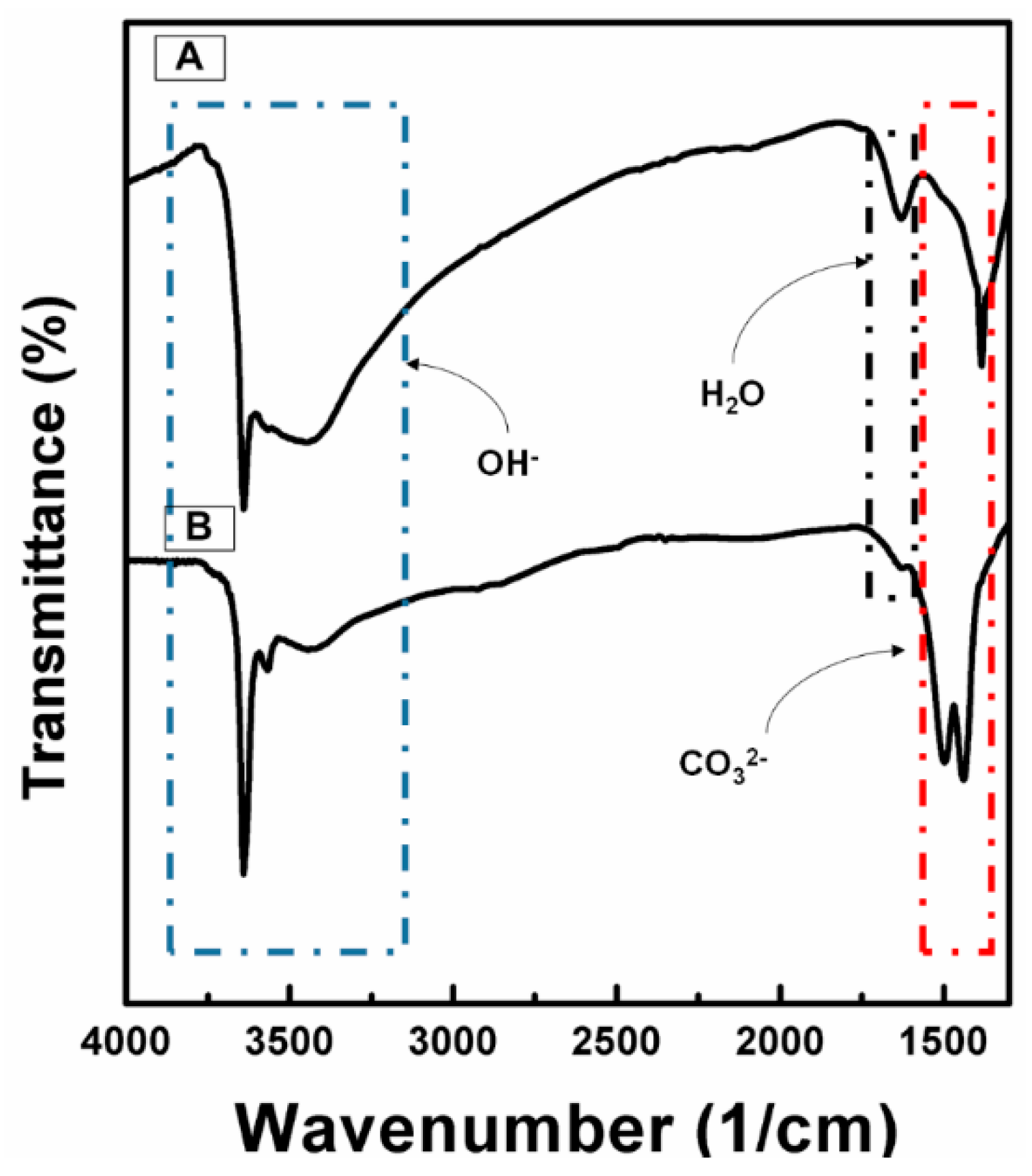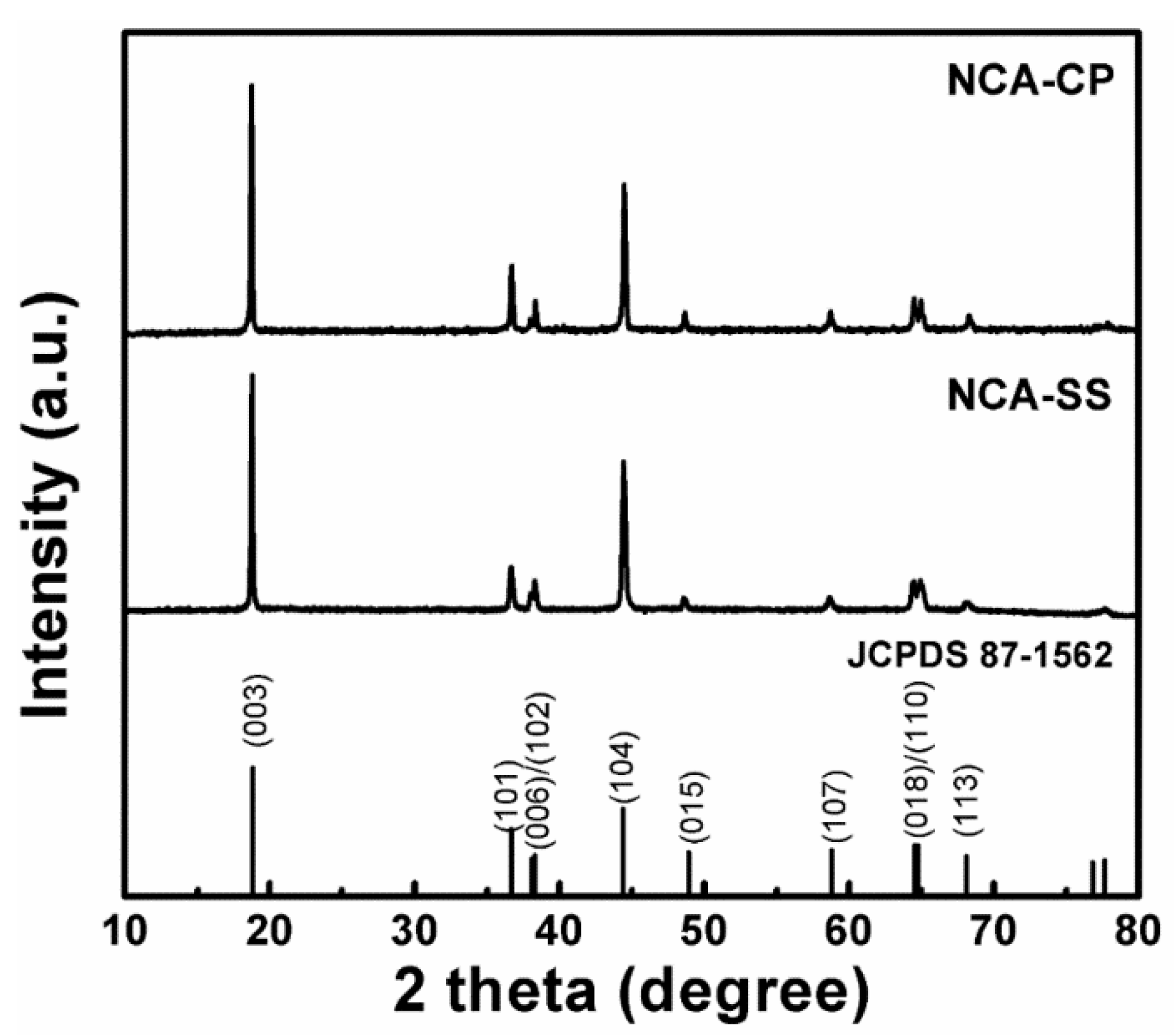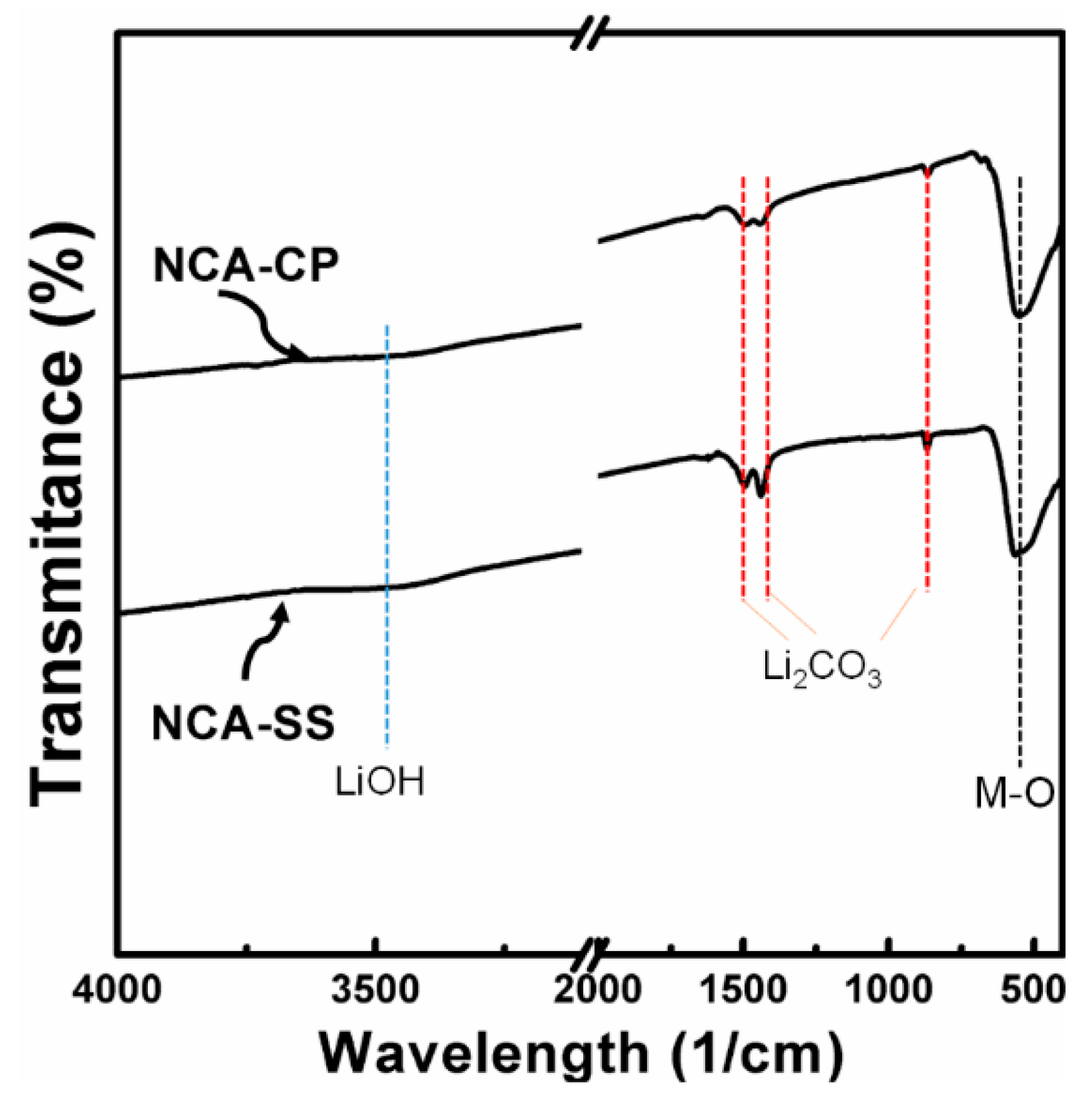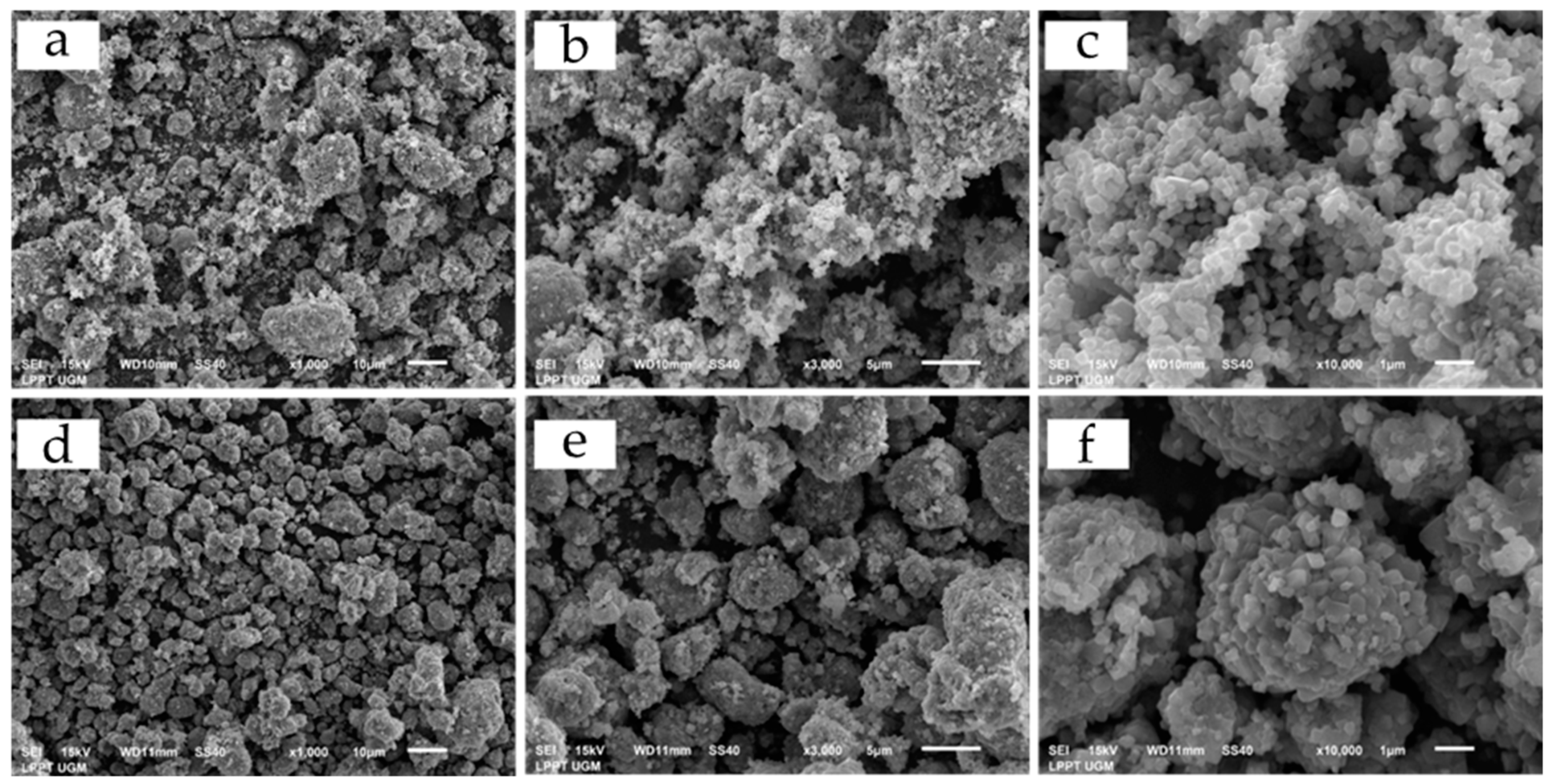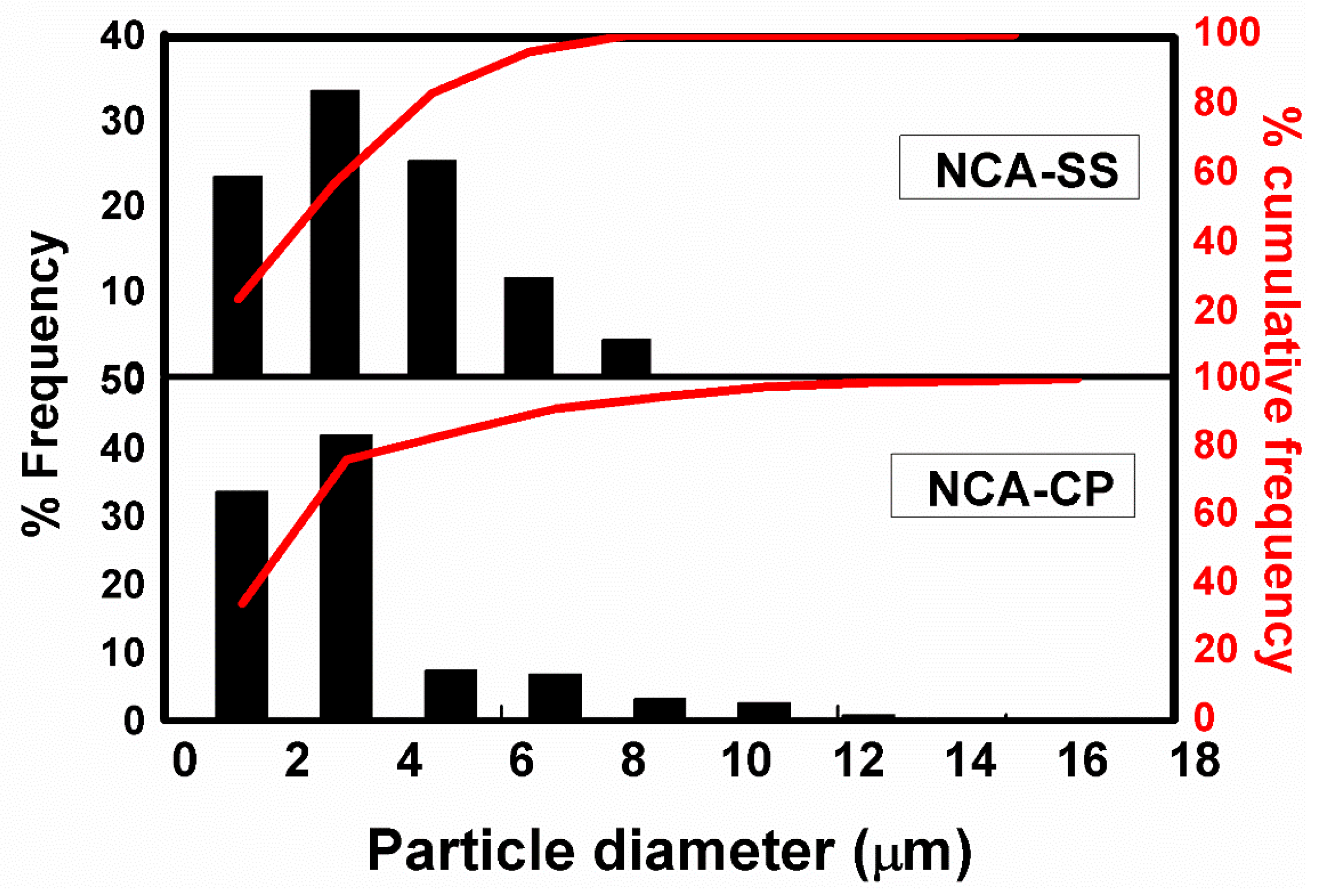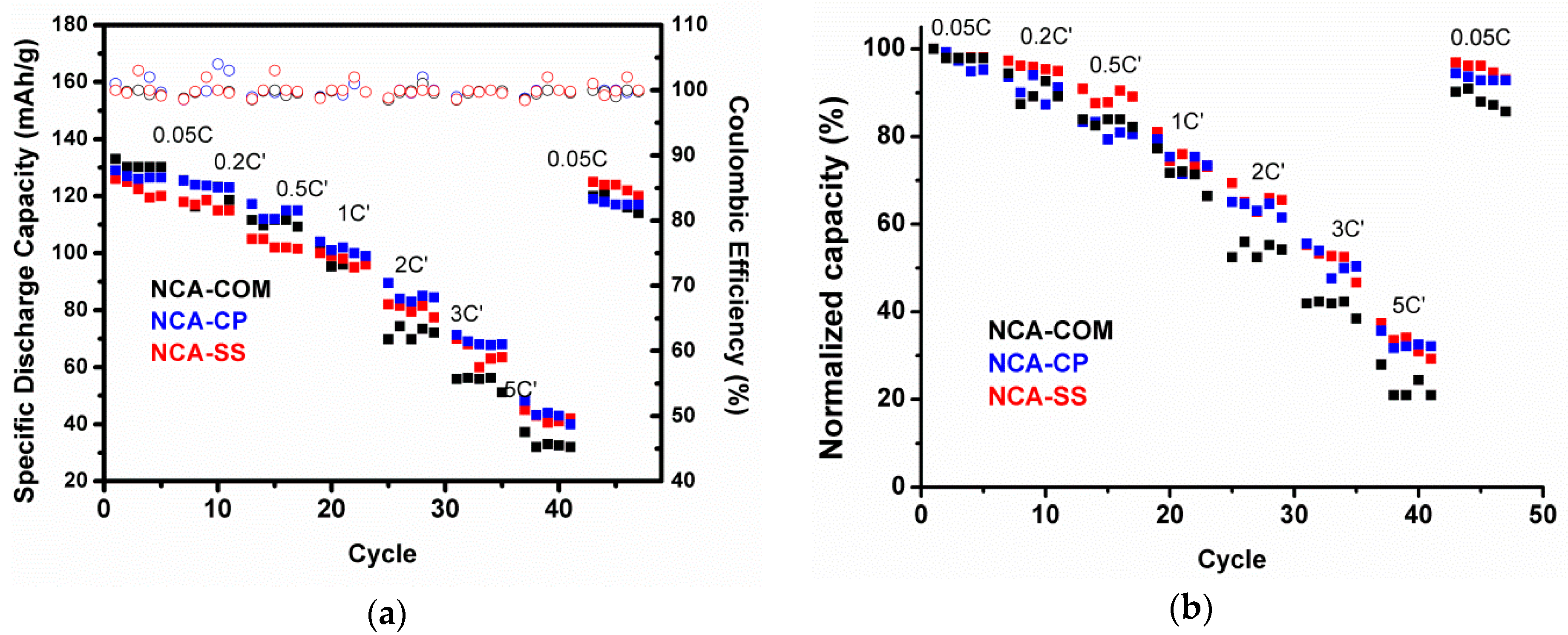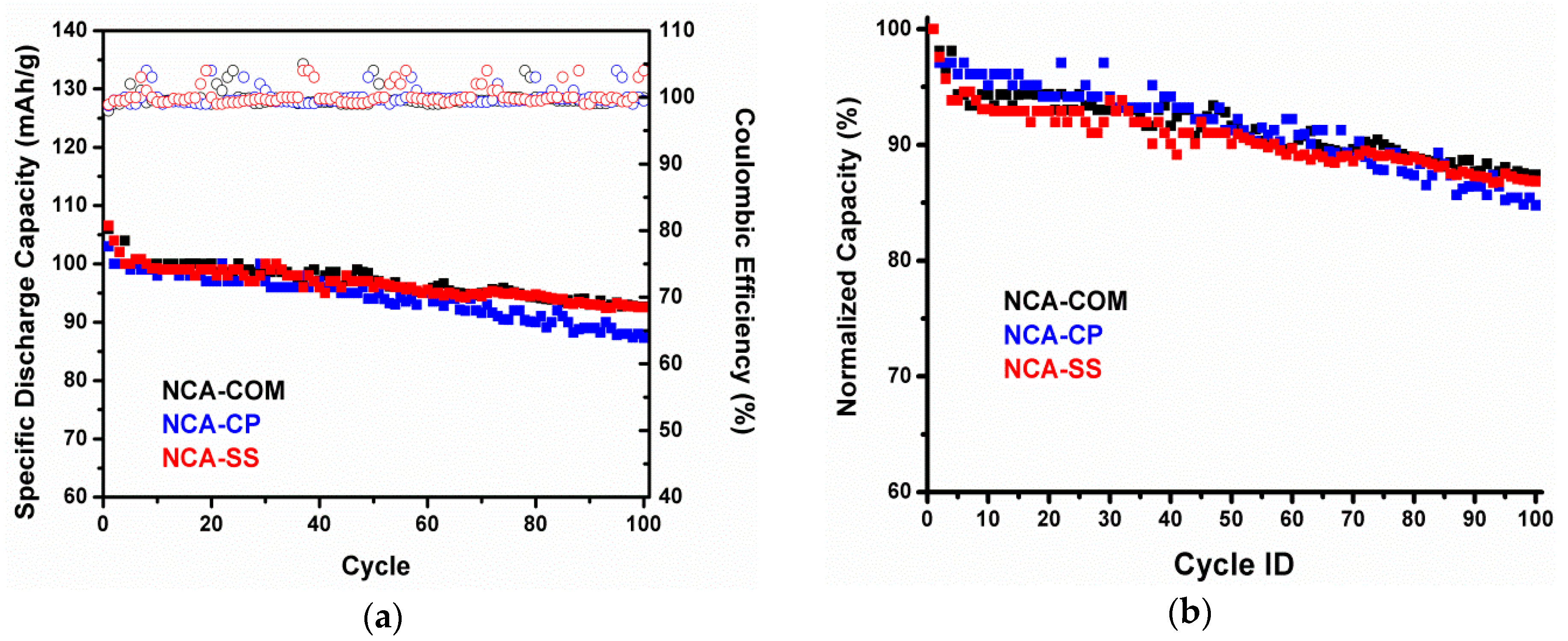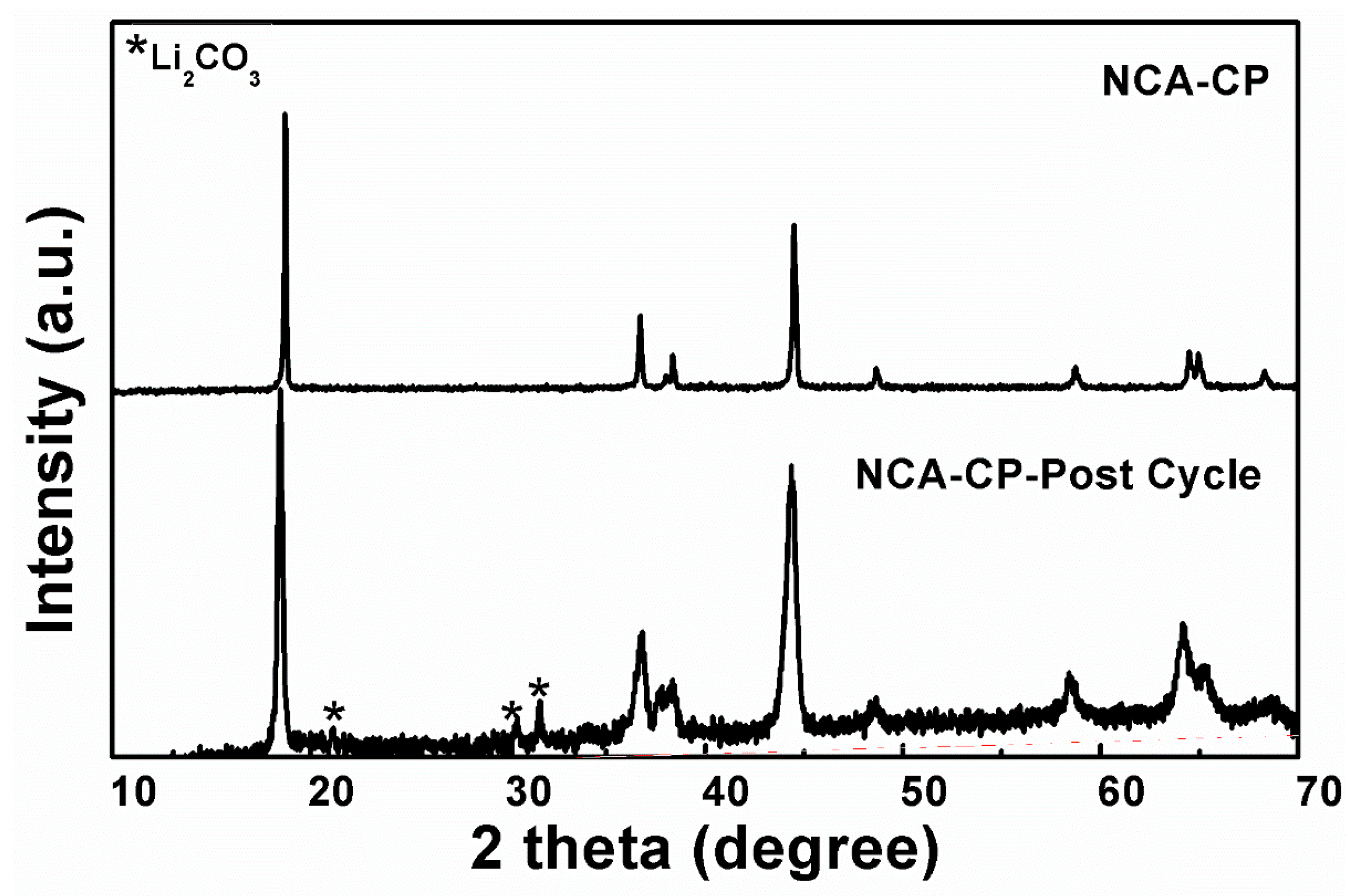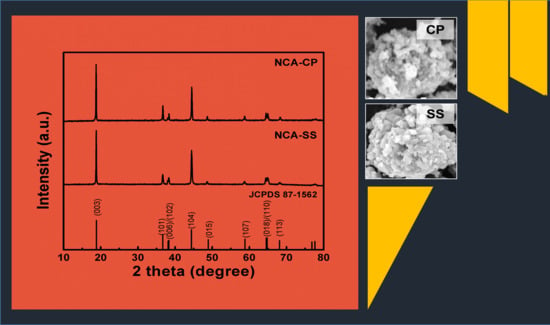3.1. NCA Precursor Characterization
Figure 1 shows the FTIR spectra of precursors from each process, namely NCA-PCP and NCA-PSS. The absorbance spectra of NCA-PCP and NCA-PSS samples show similar results to those of studies by Agarwal et al. on Ni nanoplates [
26], Motlagh et al. on Ni(OH)/NiO nanoparticles [
27], and Seo et al. on Li(Ni
0.8Co
0.16Al0.
04)O
2 materials [
15]. The sharp peak around the value of 3600/cm and the broad peak around the value 3400/cm indicate a stretching mode of the disturbed hydroxide group and stretching vibration of the free hydroxide group, which correspond strongly to the presence of metal hydroxide species (Ni(OH)
2). The peak around 1600/cm indicates the bending mode of water molecule vibration, while the peak around 1400/cm indicates a CO
32− stretching band, so it could be concluded that the sample contained carbonate and water species due to the direct contact of sample powders with air during the preparation. Double peaks which occurred in NCA-PSS were caused by the presence of LiOH in the composite, which is easily converted to Li
2CO
3 under an atmospheric condition. As a result, sample NCA-PSS has a stronger carbonate peak compared to NCA-PCP. Based on
Figure 1, the co-precipitation of the hydroxide precursor using technical grade starting materials shows no observable oxide impurities, which often occurs during atmospheric co-precipitation of Co in a highly alkaline solution [
28]. The oxidation of Co is prevented due to the de-aeration process before the co-precipitation process occurs.
3.2. NCA Samples Characterization
Both samples were heat treated evenly using the same procedure, which was a calcination and sintering process. To assure the structural quality of NCA samples, the samples were analyzed using XRD.
Figure 2 presents the XRD patterns of as-prepared NCA samples after heat treatment. It is clear that all samples exhibit a layered α-NaFeO
2-like hexagonal structure (space group: R_3m). Highly crystalline peaks are in good agreement with The Joint Committee on Powder Diffraction Standards (JCPDS) card no. 87-1562, with no observable impurities phase. The peak splits of 006/102 and 018/110 could be clearly observed in both samples, hence it could be concluded that the NCA-PC and NCA-SS have a well-ordered layered structure [
8,
29,
30]. As it has been predicted before, the use of hydroxide starting materials in a conventional solid state method will result in better mixing and homogenization of material, which does not require multiple milling and a long sintering time, as well as special tools, like in previous studies [
7,
8,
30,
31]. A well-ordered degree of layered material could be evaluated using the lattice parameters and R value. The lattice parameters of each product were calculated using the least square regression method. The crystallite size of each sample was obtained via the Debye–Scherrer equation utilizing the full width at half maximum (FWHM). Both lattice parameters and crystallite size are listed in
Table 2. It is clearly shown that the c/a value of both samples is above 4.899, which, according to Zhu et al., means that the sample exhibits a more ordered layered structure. In addition, the R value of both samples is below 0.45, which indicates good hexagonal ordering of the lattice [
32].
The presence of Ni
2+ which occurs during phase formation could negatively affect the performance of NCA cathode material, mainly due to its similar radii, with Li atomic radii resulting in the substitution of Li with Ni
2+. A stable Ni
2+ ion is very hard to oxidize, which will block the Li-ion pathway, so its intercalation and de-intercalation process is hindered, resulting in a poor electrochemical performance. Such a phenomenon is called cation mixing and its degree or level could be indicated by evaluation of the I003/I104 value. The intensity ratio of I003/I104 listed in
Table 2 strongly depends on the method. Based on previous studies on Ni-rich cathode material, the higher the value of I003/I104, the lower the cation mixing level of the material [
15,
30,
33,
34].
The surface composition of the NCA samples is conducted by analyzing the FTIR spectrum measurement, as shown in
Figure 3. It can be clearly seen that the carbonate compound is found on the surface of the sample (860/cm, 1492/cm, and 1499/cm), which could be attributed to Li
2CO
3 as a result of excess Li source [
35,
36]. During the heating process, hydroxide and carbonate species, as confirmed in
Figure 1, are decomposed into H
2O and CO
2, while residual LiOH is converted into Li
2CO
3, so the former peaks are observable, while the LiOH peak is hardly noticeable. Previous studies have suggested performing washing of the obtained NCA powders; however, washing such material using demineralized water may cause structural change, e.g., an inactive rock-salt structure, and to overcome such phenomena requires a reheating process at a high temperature that is considered uneconomical [
36]. Therefore, we decided not to perform any further treatments of the samples.
Figure 4 presents SEM images of as-prepared samples at various magnifications. From the figure, all samples have nano-sized to submicron-sized primary particles which agglomerate to form larger spherical secondary particles. NCA-SS secondary particles show a smoother morphology and denser sphere compared to NCA-CP particles due to the morphology of raw materials, especially Ni(OH)
2, which also has a spherical shape. The tapped density of NCA-CP is 1.93 g/cm
3, while the tapped density of NCA-SS is 2.17 g/cm
3. The starting materials could maintain their shape and morphology during the synthesis process, while previous studies of the solid state method using similar material have shown different morphologies of the finished product due to multiple grinding processes [
7,
8]. NCA-CP has a lower density compared to NCA-SS, which may be affected by the process during the batch co-precipitation. The presence of Al
3+ ions may hinder the formation of dense secondary particles due to the natural amphoteric habit of Al
3+, thus, during the precipitation, precipitated Al may dissolve into sodium aluminate, making the secondary particle less spherical compared to previous studies [
22,
23].
Further particle analysis was conducted using a statistical method and the results are presented in
Figure 5. Based on
Figure 4a,d, the size of the secondary particles is collected and classified into grouped data. NCA-CP and NCA-SS have a similar narrow particle size distribution. The average sizes of the particles, D10, D50, and D90, are shown in
Table 3. The D50, or the median, has been defined as the diameter where half of the population lies below this value. Accordingly, 90% of the distribution lies below the D90, and 10% of the population lies below the D10. NCA-CP samples have a relatively smaller average diameter compared to previous studies that used the continuous co-precipitation method [
22,
23,
24,
25], which, as predicted before, could be caused by aluminum ion dissolution at a high pH, which hinders particle growth [
17,
37]. However, smaller-sized particle have advantages such as a larger surface area and faster Li-ion diffusion compared to particles with a larger size.
The atomic compositions of Ni, Co, and Al examined by XRF of all samples are listed in
Table 4. It is clearly shown that Ni composition is about 83–86% among the ternary metal, which is similar to the targeted value of 85%, while the Al atom composition is far less than 1%. It is predicted that in sample NCA-CP, the Al ion is difficult to precipitate, which largely depends on the pH of the reaction. Since the precipitation involves the formation of solid in the presence of precipitant such as OH
− ions, the process largely depends on the Ksp value of the metals. Ksp is a solubility product constant. Thus, its value can predict the occurance of precipitation [
23,
38]. The Al(OH)
3 precipitation occurs faster than Co and Ni due to its extremely low Ksp value (log Ksp Al(OH)
3 = –32.34) compared to the Ksp value of Co (log Ksp Co(OH)
2= –14.8) and Ni hydroxide (log Ksp Ni(OH)
2= –14.7) [
37]. When the Al(OH)
3 is formed, Ni(OH)
2 and Co(OH)
3 have not yet formed. This initiates a large amount of Al(OH)
3 nuclei, so the formation of smaller particles continuously occurs while the growth of the existing nuclei into larger particles is hindered [
16]. In addition, to promote larger crystal growth, the pH of the solution is elevated. However, when the pH is larger than 11, precipitated Al(OH)
3 will dissolve, forming aluminate ions.
3.3. Electrochemical Performance Test
The electrochemical performance of the samples was tested in a 18650-type full battery using commercial graphite/Mesocarbon microbeads (MTI, America) as the counter anode instead of novel anodes [
39,
40]. Such an approach is seldom reported in research papers, yet provides better evidence for material commercialization. The charge-discharge curves obtained at 1/20 C of each sample and commercial NCA (labelled as NCA-Com) are shown in
Figure 6. Additional information regarding the NCA-Com characterization is provided in the
Appendix A, specifically
Figure A1,
Figure A2 and
Figure A3, and
Table A1. The first three cycles of the battery test are considered the formation phase. The first cycle performance of three cells is listed in
Table 5. In the formation phase, the coulombic efficiency of NCA-CP, NCA-SS, and NCA-Commercial is 69.36%, 69.19%, and 72.97%, respectively. About 30% capacity loss is attributed to solid electrolyte interphase (SEI) formation on both the cathode and anode side. The difference of NCA-CP and NCA-SS coulombic efficiency is insignificant; however, the value is slightly lower than the commercial NCA. The initial specific discharge capacity of NCA-SS and NCA-CP is similar; however, the value is also slightly lower than the commercial NCA. This situation might be caused by the morphology characteristics of as-prepared samples. The smaller secondary particles followed by a large amount of aggregates have a larger surface area, thus promoting side reactions between the materials with the electrolyte during the first charge. These side reactions might form a passivation layer, resulting in irreversibility in electrochemical performances [
30,
41,
42]. In a study by Hsieh et al. [
31], the low capacity and high irreversibility level on NCA cathode material were caused by the high amount of aggregates present during the synthesis and defect in the lattice. The initial specific discharge capacity of each cell is considered as the actual capacity and later denoted as C’. Therefore, the value of the 1 C’ rate of NCA-CP, NCA-SS, and NCA-Com is 126.1 mA/g, 129.1 mA/g, and 135.03 mA/g, respectively.
The rate-ability of NCA samples is shown in
Figure 7 using a standard testing procedure in which the charging and discharging rates were set using the actual capacity presented in
Table 5 (C’) rather than the theoretical capacity (C). After the cells went through the formation phase for five cycles, the cells were charged at 0.5 C’ and discharged at various discharging rates. Based on
Figure 7, sample NCA-SS and NCA-CP have a similar rate performance behavior and are relatively comparable to commercial NCA. Surprisingly, at a higher rate, NCA-SS and NCA-CP are superior compared to commercial NCA. Such a phenomenon occurred due to the higher surface area of the as-prepared samples. At high current rates, the performance of cells depends on the Li ion mass transfer and diffusion kinetics. Therefore, even though a large surface area promotes side reactions, it becomes beneficial during a high rate discharging process [
17]. To prove the reversability of the material, the cells were charged and discharged using the first rate (10 mA/g or 0.05 C). From the figure, it appears that all samples exhibit a small capacity drop, even after being discharged at high current rates.
Figure 8a shows the cycle performance of NCA-CP and NCA-SS, respectively. The normalized capacity in
Figure 8b refers to the actual capacity, the initial capacity, of each sample. NCA-CP and NCA-SS have similar cycling behaviors for 100 cycles at 1 C’ rates and have a capacity retention of 84.4% and 86.3%, respectively. The capacity drop occurred during the initial cycles; however, after three to four cycles, the capacity is considered stable after 100 cycles. The capacity drop phenomena is similar to the study result of Zhang et al., hence the capacity drop of samples in the NCA-battery resulted from impedance rising and cell polarization [
43]. Overall, the cycle performance of NCA-CP and NCA-SS is comparable to the commercial NCA. Major problems in NCA commercialization rely on the synthesis methods. Based on the electrochemical performance test results, more feasible, scalable, and commercially attractive methods, such as facile batch co-precipitation and the solid state method, could produce NCA cathode material with comparable performances to commercial NCA which is produced by a continous co-precipitation process. In addition, the use of technical grade raw materials in NCA-CP provides stronger evidence on the merits of the method. Overall, NCA-SS shows a slightly better performance compared to NCA-CP. The higher I003/I104 value based on the XRD pattern and better morphology according to the SEM result might be the reasons behind the difference in the performance, specifically in terms of the capacity.
Post-structural analysis was performed to investigate the reason for low capacity loss during the first cycle. The XRD patterns of the NCA-CP pre-cycle and post-cycle are displayed in
Figure 9. From the figure, impurities are clearly observed at two theta around 20–32°, which could be indexed with Li
2CO
3 (JCPDS card no. 87-0729). The formation of Li
2CO
3 or other carbonate compounds such as ROCO
2Li occurred due to side reactions between the electrolyte and the cathode material promoted by the large surface area of aggregates, confirming previous results [
31,
35,
42]. The post-cycle sample patterns have a broader peak compared to the pre-cycle sample, which indicates a decrease in crystallinity; however, the layered structure of the NCA sample is not altered after cycling and is proven by lattice parameter analysis listed in
Table 6. The sample exhibits a slight cell volume change (less than 1 Ǻ
3) after the cycle and slight decrease in the I003/I104 ratio, which indicates a rigid structure and minimum Li
+/Ni
2+ mixing in the lattice, respectively, resulting in a good cycle-ability and reversibility during rate performance.
